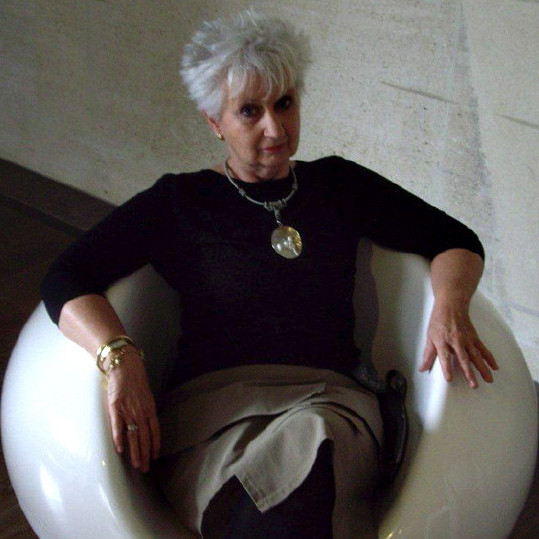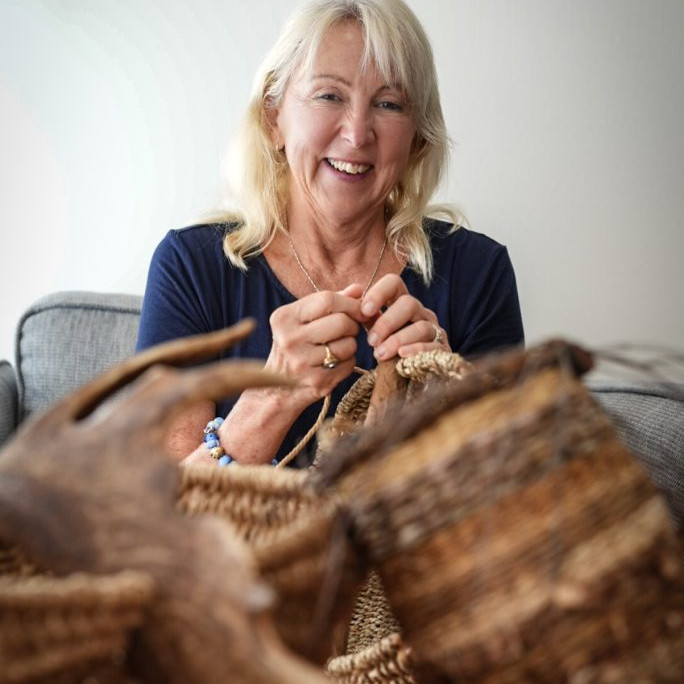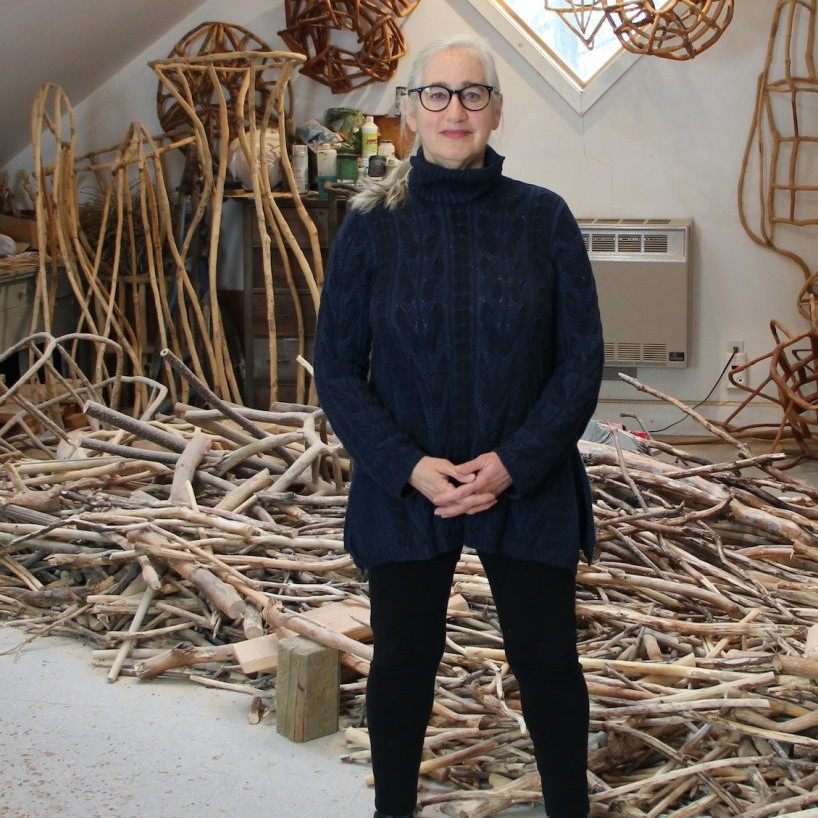Chris Maynard Eco Artist - Olympia, WA, USA
You have been working with bird feathers since you were twelve. Can you discuss your love affair with feathers?
I still have some of the flamingo feathers from going to the zoo with my grandfather. They remain a fascinating gift from the birds. I love that they are essentially gifts because the birds naturally shed them about once a year and yet they retain their complexity and beauty. There is nothing else remotely like feathers.
I have written a tabletop picture and text book which is due out late this spring; Feather Form and Function, what they are, how they work, why we find them alluring. Over the years I gained a lot of knowledge about what feathers are how they grow and work. Writing this book stepped up the learning process; I am always interested to learn more. I delved into the meaning we associate with feathers in this book—another fascinating subject.
What lead you to creating your first bird feather art in 2010?
2010 was not my first feather art—I have worked with feathers in various ways all my life. Wanting to have a more tactile way for people to experience feathers than a flat photograph and express more themes, was one thing. Another was wanting to keep the feathers in their three dimensional shapes. Cutting out bird silhouettes was a logical progression in developing themes and meanings and telling stories.
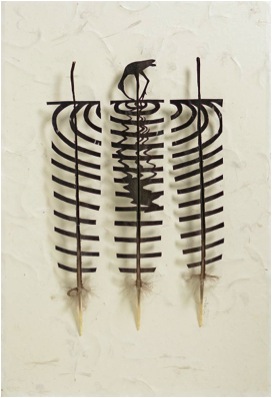
You mount your work in frames or as you call them shadow boxes. Please discuss this aspect of your work?
Feathers are naturally curved and I want to respect that. So I don’t; flatten them in one plane on the surface of the background. I set them away from their backing so the feathers can keep their curves thereby creating an added design element—shadows. A piece varies in its presentation by the direction, intensity and type of light shining on it.
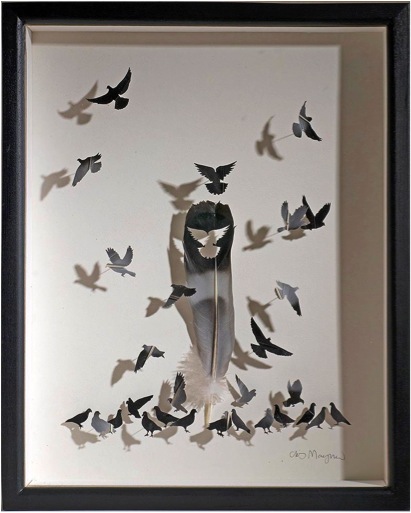
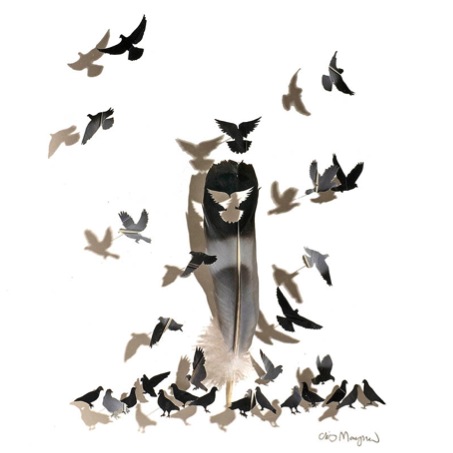
‘City Park Pigeons’
Your feathers are mainly from natural moulting and collected from museums, zoos and private aviaries. Can you discuss the collecting process?
People pick them up on the floors of the pens and send them to me. I sort and label them, freeze them and store them.
Discuss the size of feathers you work with?
I like to work with feathers from the birds I am portraying. But small birds have tiny feathers so I have to use those of larger birds like turkeys and pheasants
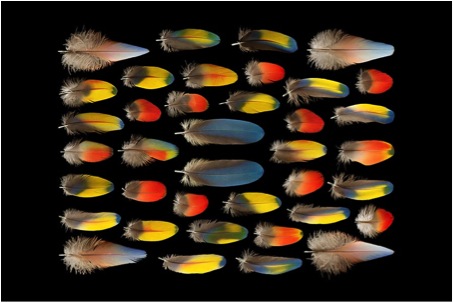
What cleaning process do you put your feathers through before using them?
I freeze them for 48 hours, at 0 degrees F.; then take them out for another 48 hours to allow any mite eggs to hatch, then freeze for another 48. That is it. I have a 20 year-old shadowbox of feathers that are in perfect condition. If any pest problem did develop, I would just freeze the feathers again. If they are dirty, I will wash them with detergent and gently dry them.
Discuss the legal ramification to your work?
I use only feathers that are legal to possess. Laws protecting birds which include possession and sale of feathers in both our countries are quite complicated. Not harming birds and supporting laws to protect them is in my interest as a major goal of mine is conservation.
Often your work is using a single feather that releases into a flock of birds. Can you discuss the combination of many small birds and the remaining original feather?
Birds do what we yearn to do—fly. That is a major theme in terms of what feathers mean to us. Delight the miraculous, escape from our circumstances, transformation, bridges between heaven and earth, here and a spirit world; all are themes associated with feathers. Drawing out that meaning using a central feather with birds cut-outs flying out has been a natural outgrowth of this idea.
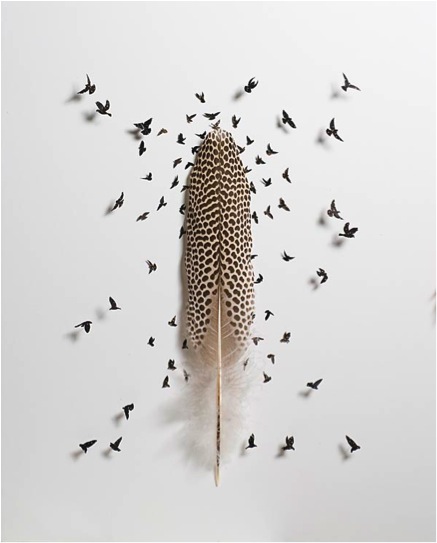
In other works you use multiple feathers in a series or sequence setting, can you expand on this approach?
I’m not sure what you mean here or which piece you refer to. I’ll take a guess using Red Tailed black cockatoo feathers. From US raised captive birds I have the most beautifully coloured tail feathers—the red-tail black cockatoo that I used in a couple of pieces. It pictured three feathers with a bird cut out in each perched in an oval cage. This piece tells a story which I elaborated on by writing a poem for a children’s book to go with the image [the book has not been published]:
Shall I go or shall I stay
Take to wing and fly away?
But it’s safe, my food is here
Choices are not always clear
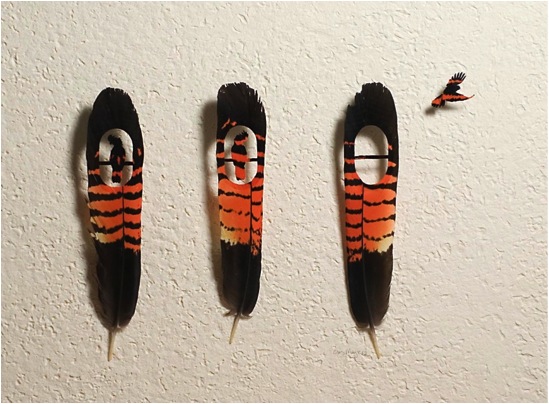
Can you explain how your work is titled?
Some titles I am happy with, others not so much. I like to capture the essence of the meaning or feeling I am trying to convey. The title may relate to the behaviour of a specific bird or to a general theme associated with birds or their feathers. For instance, my latest series is simply entitled, ‘Eat’. I am working on ‘Eat 7’, the seventh in a series. The idea is that bird feathers are reconstituted from what a bird eats metabolized.
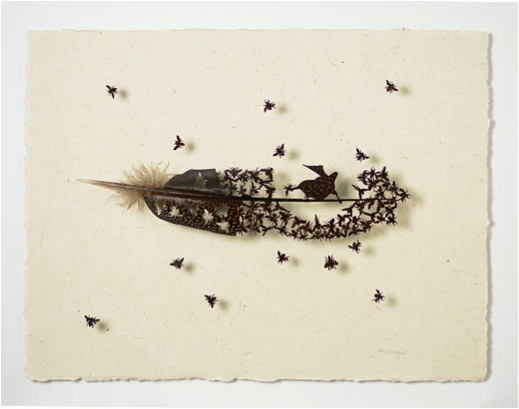
Do you work freehand or have you done extensive drawings before the first cut?
Extensive drawings are the rule. I draw initial sketches of ideas. When I choose one to pursue, I sketch it out in more detail; make mock-ups, and choose the right feather—I often have a feather in mind. If not; I search for the right one. Feathers are very limited in size colour and pattern.
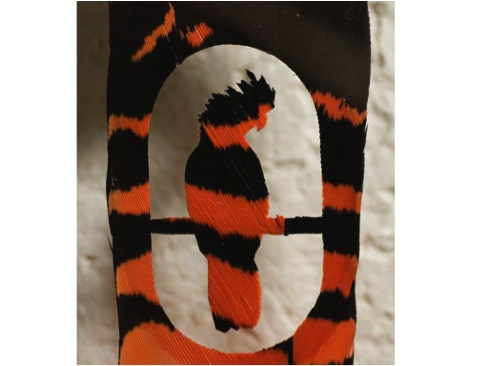
Please discuss your feather photography and some of your processes?
A lot of feathers are illegal to have in Australia as well as my country. Taking photographs means that one does not have to have the feather, just take a picture—this expands the kinds of feathers I can work with.
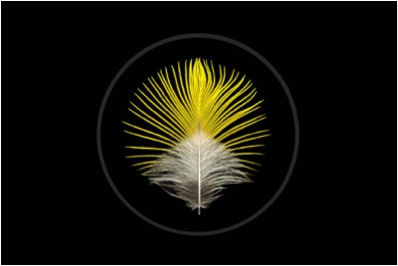
I have developed several ways to take pictures that bring out the details of the feathers. One is to have a completely black background which can be accomplished in several ways, photographically. Side lighting brings out the surface topography of the finely structured surface by casting small shadows.
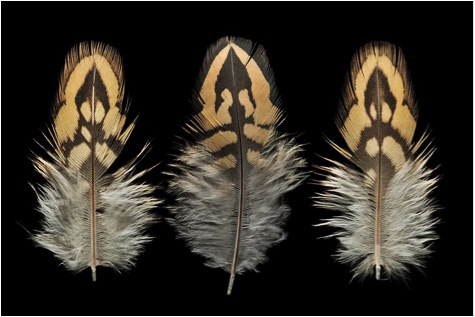
Can you discuss your Feather Alphabet?
Off a bird, its individual feather patters are striking. On the bird, they provide camouflage and blend in. The meaning or what patterns remind us of is entirely made up—they are patterns we recognize from other things—like letters and numbers. They have nothing to do with the actual bird and mean nothing to the bird. They just help the bird to hide. But meaning is important to us so we will persist in this kind of endeavour.
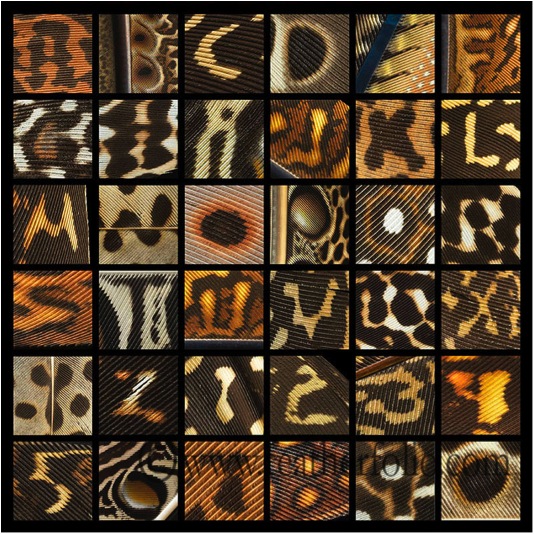
This bird has the most varied patterns in its feathers of any bird on Earth. All colours are made by the most common colouring pigment in bird feathers: melanin. This makes the russet browns, browns, blacks and greys. In the alphabet, they make for a rather subtle effect—you really have to take some time to look for some letters and numbers as the letters may be inverse. I thought it would be good for school children as they learn the alphabet but I have been told by early childhood education specialists that the younger children need more defined letters for learning. I was told by a writing specialist that when children are older and have learned the alphabet, say ten or eleven, that looking at this feather alphabet can expand their thinking and seeing—because they really have to look—they are drawn in.
I have relationships and friendships with aviary owners. They are busy people and usually only able and willing to pick up the larger feathers to send to me.
Discuss your membership of Artists for Conservation and its importance to you?
Conservation issues are at the heart of my work. I want people to see the world through feathers in a new way; take a moment to breathe, appreciate life. I hope by appreciating feathers and birds by seeing them in a different perspective, that these creatures will get more respect and therefore concern for their welfare.
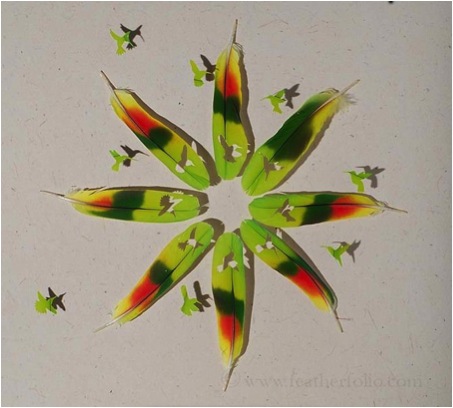
I am a new artist member with Artists for Conservation. I plan to write for their blog and just gave them my first of what I hope to be a series of three articles on feather coloration which has applications for all artists.
I am not new to advocacy for conservation issues. Currently I am working as an artist with the Macaw Rescue Foundation based in London and Ontario to provide a piece for fundraising to reintroduce a species of Macaw to the forests of Bolivia. I just gave the annual talk to the Audubon Society in the USA on the topic of feathers. My talks follow the contents of my new tabletop picture and text book, Feather Form and Function: what feathers are, how they work, and why we find them alluring.
Contact details.
Website:www.featherfolio.com
Email:chris@featherfolio.com
Chris Maynard, Olympia, WA, USA
Interview by Deborah Blakeley, May, 2014
Think a colleague or friend could benefit from this interview?
Knowledge is one of the biggest assets in any business. So why not forward this on to your friends and colleagues so they too can start taking advantage of the insightful information the artist has given?
Other artists you may be interested in:

